ROOT CANAL TREATMENT
What is a Root Canal?
Root canal treatment is designed to eliminate bacteria from the infected root canal, prevent reinfection of the tooth and save the natural tooth. When one undergoes a root canal, the inflamed or infected pulp is removed and the
inside of the tooth is carefully cleaned and disinfected, then filled and sealed.
Does a root canal hurt?
Since patients are given anesthesia, a root canal isn’t more painful than a regular dental procedure, such as a filling or getting a wisdom tooth removed. However, a root canal is generally a bit sore or numb after the procedure, and can even cause mild discomfort for a few days.
How do you know if you need a root canal?
Root canals are needed for a cracked tooth from injury, a deep cavity, or issues from a previous filling. Patients generally need a root canal when they notice their teeth are sensitive, particularly to hot and cold sensations.
There are a few symptoms that mean you might need a root canal—
- Severe pain while chewing or biting
- Pimples on the gums
- A chipped or cracked tooth
- Lingering sensitivity to hot or cold, even after the sensation has been removed
- Swollen or tender gums
- Deep decay or darkening of the gums
How much does a root canal cost?
The cost varies depending on how complex the problem is and which tooth is affected. Molars are more difficult to treat; the fee is usually more.
Generally, endodontic treatment and restoration of the natural tooth are less expensive than the alternative of having the tooth extracted. An extracted tooth must be replaced with an implant or bridge to restore chewing function and prevent adjacent teeth from shifting. These procedures tend to cost more than endodontic treatment and appropriate restoration.
Myths About Root Canals
The thought of a root canal may make you fearful or uneasy if you aren’t familiar with the procedure. There are common misconceptions that endodontic treatments such as root canals, cause pain and/or illness and should be avoided at all costs. The exact opposite is true. The pain, inconvenience and cost of avoiding endodontic treatment in favor of tooth extraction or a wait-and-see approach can be easily avoided. The longer you postpone treatment the more you risk the chance to save your tooth. Take the time to read the information on our website to find out what your dentist do to save teeth with minimal time and discomfort. Then address any remaining concerns or questions with your dentist .
step by step process in picture formate
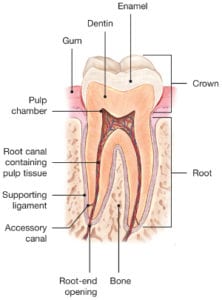
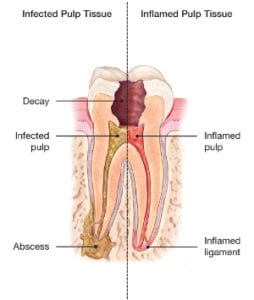
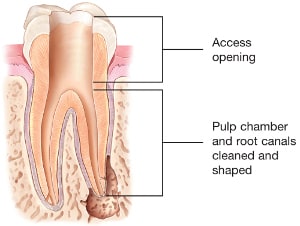
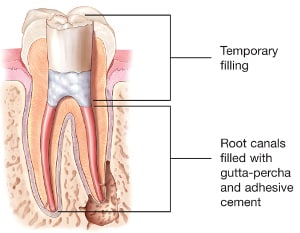
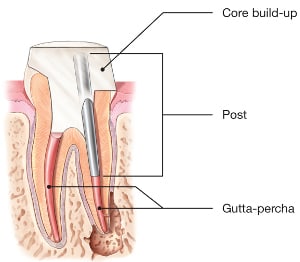

single sitting Painless RCT?
DR VEERENDRAKUMAR,s Dental Surgery Centre Advanced Dental Speciality Clinic offers Single sitting /painless RCT since 1999.
Advantages of single sitting RCT:
- Reduced patient’s appointment
- Risk of inter appointment contamination and flare up chances.
- Reduced patient and operator fatigue
- Help full in patient who required full mouth rehabilitation
- Physically disabled patients who cannot come to dental clinic frequently
- Patient who require sedation during treatment
frequently asked questions







Frequently Asked Questions. Has your dentist told you that you need root canal? If so, you're not alone. Millions of teeth are treated and saved each year with the root canal, or endodontic, treatment. This page explains root canal treatment in detail and how it can relieve your tooth pain and save your smile.
“Endo” is the Greek word for “inside” and “odont” is Greek for “tooth.” Endodontic treatment treats the inside of the tooth. Root canal treatment is one type of endodontic treatment.
To understand endodontic treatment, it helps to know something about the anatomy of the tooth. Inside the tooth, under the white enamel and a hard layer called the dentin, is a soft tissue called the pulp. The pulp contains blood vessels, nerves and connective tissue and creates the surrounding hard tissues of the tooth during development.
The pulp extends from the crown of the tooth to the tip of the roots where it connects to the tissues surrounding the root. The pulp is important during a tooth’s growth and development. However, once a tooth is fully mature it can survive without the pulp, because the tooth continues to be nourished by the tissues surrounding it.
Endodontic treatment is necessary when the pulp, the soft tissue inside the root canal, becomes inflamed or infected. The inflammation or infection can have a variety of causes: deep decay repeated dental procedures on the tooth or a crack or chip in the tooth. In addition, an injury to a tooth may cause pulp damage even if the tooth has no visible chips or cracks. If pulp inflammation or infection is left untreated, it can cause pain or lead to an abscess.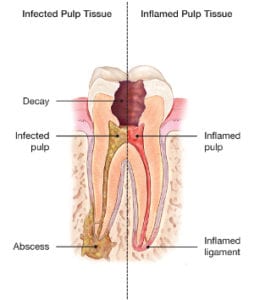
There are a few symptoms that mean you might need a root canal—
- Severe pain while chewing or biting
- Pimples on the gums
- A chipped or cracked tooth
- Lingering sensitivity to hot or cold, even after the sensation has been removed
- Swollen or tender gums
- Deep decay or darkening of the gums
The endodontist removes the inflamed or infected pulp, carefully cleans and shapes the inside of the root canal, then fills and seals the space. Afterward, you will return to your dentist, who will place a crown or other restoration on the tooth to protect and restore it to full function. After restoration, the tooth continues to function like any other tooth.
Many endodontic procedures are performed to relieve the pain of toothaches caused by pulp inflammation or infection. With modern techniques and anesthetics, most patients report that they are comfortable during the procedure.
For the first few days after treatment, your tooth may feel sensitive, especially if there was pain or infection before the procedure. This discomfort can be relieved with over-the-counter or prescription medications. Follow your endodontist’s instructions carefully.
Your tooth may continue to feel slightly different from your other teeth for some time after your endodontic treatment is completed
Endodontic treatment can often be performed in one or two visits and involves the following steps:
- The endodontist examines and takes a radiograph of the tooth using x-rays, then administers local anesthetic. After the tooth is numb, the endodontist places a small protective sheet called a “dental dam” over the area to isolate the tooth and keep it clean and free of saliva during the procedure.

- The endodontist makes an opening in the crown of the tooth. Very small instruments are used to clean the pulp from the pulp chamber and root canals and to shape the space for filling.

- After space is cleaned and shaped, the endodontist fills the root canals with a biocompatible material, usually a rubber-like material called gutta-percha. The gutta-percha is placed with an adhesive cement to ensure complete sealing of the root canals. In most cases, a temporary filling is placed to close the opening. The temporary filling will be removed by your dentist before the tooth is restored.
- After the final visit with your endodontist, you must return to your dentist to have a crown or other restoration placed on the tooth to protect and restore it to full function.
If the tooth lacks sufficient structure to hold the
 restoration in place, your dentist or endodontist may place a post inside the tooth. Ask your dentist or endodontist for more details about the specific restoration planned for your tooth.
restoration in place, your dentist or endodontist may place a post inside the tooth. Ask your dentist or endodontist for more details about the specific restoration planned for your tooth.
- The endodontist examines and takes a radiograph of the tooth using x-rays, then administers local anesthetic. After the tooth is numb, the endodontist places a small protective sheet called a “dental dam” over the area to isolate the tooth and keep it clean and free of saliva during the procedure.


The cost varies depending on how complex the problem is and which tooth is affected. Molars are more difficult to treat; the fee is usually more. Most dental insurance policies provide some coverage for endodontic treatment.
Generally, endodontic treatment and restoration of the natural tooth are less expensive than the alternative of having the tooth extracted. An extracted tooth must be replaced with an implant or bridge to restore chewing function and prevent adjacent teeth from shifting. These procedures tend to cost more than endodontic treatment and appropriate restoration.
You should not chew or bite on the treated tooth until you have had it restored by your dentist. The unrestored tooth is susceptible to fracture, so you should see your dentist for a full restoration as soon as possible. Otherwise, you need only practice good oral hygiene, including brushing, flossing, and regular checkups and cleanings.
Most endodontically treated teeth last as long as other natural teeth. In a few cases, a tooth that has undergone endodontic treatment does not heal or the pain continues. Occasionally, the tooth may become painful or diseased months or even years after successful treatment.
New trauma, deep decay, or a loose, cracked or broken filling can cause new infection in your tooth. In some cases, the endodontist may discover additional very narrow or curved canals that could not be treated during the initial procedure.
Most teeth can be treated. Occasionally, a tooth can’t be saved because the root canals are not accessible, the root is severely fractured, the tooth doesn’t have adequate bone support, or the tooth cannot be restored. However, advances in endodontics are making it possible to save teeth that even a few years ago would have been lost. When endodontic treatment is not effective, endodontic surgery may be able to save the tooth.
After a root canal, try to eat soft foods that require very little chewing, like applesauce, yogurt, eggs, and fish. Avoid hard or hot foods that might hurt your teeth. Some dentists suggest to not eat for a few hours until the numbness in your mouth wears off so you don’t bite your cheek or tongue.
A root canal is performed when the DENTIST removes the infected pulp and nerve in the root of the tooth, cleans and shapes the inside of the root canal, then fills and seals the space. Afterward, your dentist will place a crown on the tooth to protect and restore it to its original function.
For the first few days after a root canal, some patients experience sensitivity, swelling, or inflammation, while others experience an uneven bite or a reaction to the medication provided by the endodontist. Regardless of symptoms, a follow-up appointment is almost always needed.
A root canal does not kill the tooth, and after a root canal is complete, the tooth will be able to function as it normally does. However, root canals do remove the nerves inside the tooth, but these nerves serve very little function in a fully formed tooth.
implants is far more in favor of basal implants comparing to conventional implants. That is due to the clever and simplified implants design, and innovative surgical techniques.
When the dental implant treatment has been calculated, normally the price of the implants, restoration, and the surgeon expertise are being considered. But just few of the patients, take in to consideration, the time spent because of the higher number and length of the visits. Few of the patients calculate the time when they will experience, some times serious discomfort, because of loss of normal chewing function, while waiting for the conventional implants to “heal”, or newly augmented bone to get its vitality and implant bearing capacity. Some times, in complex cases, when employing conventional techniques, it takes up to year, year and a half from the beginning to the desired end result- fixed teeth. The patients treated with the concept of basal implantology will get stable, fixed on implants teeth in just a few days, irrespectively of the complexity of the treatment.
Needing a crown after a root canal depends highly on the location of the tooth in the mouth—teeth towards the back of the mouth like molars and premolars are needed more for chewing, and generally require crowns, where incisors or canines which aren’t needed for chewing don’t always require crowns.
Yes, it is possible. And it is the preferred method also. Placing the implant in the same visit helps preserve both width and height of the bone and may prevent the need for placing bone grafts as bone naturally shrinks back after teeth are extracted. During the first year after teeth have been removed, as much as 40% of jaw bone width can be lost. If it is possible to place the implant in the same visit as the teeth are extracted, this can save at least three months of healing time compared to waiting for an extraction site to heal before the implants are placed. And in the single visit, both extraction and implant placement are completed. In single anaesthesia, both procedures are done. No need for multiple injections and multiple surgeries.
All commercially available dental implant is ma
If left untreated, the infection in the tooth can spread to other parts of the body, and in some cases can even be life threatening. If you are in need of a root canal, the infected pulp in the tooth needs to be removed.
de of titanium alloy(T16A14v) which is bio compatible and highly resistance to fracture
Please contact your implantologist im
Sometimes after a root canal, the tooth can become slightly discolored or develop spots called intrinsic stains, where the tooth bleeds internally and the inner part of the tooth turns yellow or dark. Luckily, the tooth can be whitened afterward through internal (non-vital) bleaching.
mediately. Mobilization (loosening) is sometimes simply a reaction of the bone to inappropriate loading or overloading. The advantage of Cortical implants compared to any conventional implant is that the bone remodelling process occurs deep inside the sterile bone. By contrast, if a conventional implant becomes mobile, pathogens will quickly enter the zone where the implant emerges from the gums, resulting in infection and, ultimately, implant loss. CORTICAL implants in this situation will stabilize if an occlusal correction is made in time
It is always better to maintain a healthy, natural smile whenever possible, and root canals allow for just that. Extracting and then replacing a tooth results in more treatments and procedures, and could even impact neighboring teeth and supporting gums.
Waiting too long to get a root canal can oftentimes result in tooth loss. This generally occurs when the root of an infected tooth has gone untreated for so long that results in bone loss. Many times with severe furcation, it might be too late for a root canal and the tooth would need to be extracted.
You can eat normally before a root canal treatment, and most endodontists even allow patients to eat up to 1 hour before a procedure. However, as with all oral procedures, most endodontists prefer that you brush your teeth prior to the appointment.
After a root canal, make sure to follow all of your dentist’s instructions, which most often include avoiding hard or especially chewy foods, brushing twice a day, and being very cautious around the area where the root canal procedure was completed.
Address
Dental surgery centre.302.vk plaza.4th phase.7th block.100 feet main ring road.Banashankari 3rd stage.opposite to apollo school.near devegowda petrol bunk.Bangalore 560085
Phone
+919844016274 /> +910826695988/87/89
iamveeru@gmail.com /> dentalsurgerycentre@gmail.com




